|
The Antiquities of the Vatican Museums
By Mike McLeod
A glimpse into one of the
greatest collections in the world-if not the greatest-will be
arriving in the U.S. in the coming months. More than 300 works of
art and historically significant objects on loan from the Vatican,
the Vatican Museums and the Sistine Chapel will be exhibited at the
Houston Museum of Natural Science in March, and later in the year at
the Ft. Lauderdale Museum of Art, the Cincinnati Museum Center and
the San Diego Museum of Art.
The exhibit entitled,
"Saint Peter and the Vatican: The Legacy of the Popes," includes
rarities encompassing 2,000 years: a reproduction of the Tomb of St.
Peter and a gold plaque found in the area of the tomb; the
Mandylion of Edessa, a 3rd-5th century image on linen
considered by some to be the oldest known representation of Jesus; a
mosaic bust of an angel by the 14th century master, Giotto; drawings
by Michelangelo, including figural studies for the ceiling of the
Sistine Chapel; Bernini's exquisite terra-cotta sculpture,
Charity with Four Putti, which has the artist's thumbprint
in the clay; and the Papal Tiara of Pope Pius IX made of silver,
gold, pearls, diamonds, emeralds, and other precious stones. Much of
this collection has never left the Vatican.
While this collection is
exquisite, there still resides in Vatican City the world's greatest
collection of masterpieces and artistic treasures concentrated in
one place. Art, sculpture, mosaics, pottery, silver, coins,
tapestries, maps, documents and books spanning 4,000 years are kept
and displayed in a series of museums collectively known as the
"Museums of the Vatican." In reality, the museums also include
corridors, libraries, courtyards, halls and rooms that display
artistic wonders. In addition, the Sistine Chapel is considered part
of the collection.
Vatican City grew up around
where tradition says Peter the Apostle was buried after being
crucified upside down (not deeming himself worthy to die in the same
manner as Jesus Christ). St. Peter's Basilica in Vatican City was
constructed over his grave, which is walking distance from the
museums of the Vatican and the Sistine Chapel.
Vatican City itself is an
independent country measuring just 109 acres with a population of
about 1,000. It has its own currency, its own army (of about 100
Swiss Guards), diplomats, and even license plates for cars.
The
origin of the Vatican Museums is traced back to the 1400s, starting
with various popes displaying their personal collections. Donations,
commissioned work and continued collecting by church authorities
have led to the current massive collection.
Every work of art in the
Vatican Museums has a story to tell, but space here allows for only
a few. One of the prized paintings with an incredible provenance is
Michelangelo's St. Jerome. Created in tempura on wood before 1482,
this dark painting in brown tones depicts St. Jerome with a lion
that, after removing a thorn from its paw, remained faithful to him.
(Sound familiar?) The painting eventually passed into the hands of a
Swiss painter and then was lost early in the 19th century. Later,
the painting was found twice-because it had been cut into two
pieces. The lower portion was discovered in a secondhand shop being
used as a cover for a chest. The upper portion with St. Jerome's
head was found five years later in a cobbler's shop where it was
part of a stool.
Apparently, Michelangelo
visited the collection during his day and appreciated the works of
art displayed there. He particularly admired one of the most famous
sculptures, the Apollo Belvedere, because he used the face
and hair for his representation of Christ in the Sistine Chapel's
The Last Judgment.
The sculptures record not
only great artistry, but also great people and events. A bust of
Socrates reveals the great Greek philosopher as having an
unremarkable appearance-a domed head, pug nose, small eyes and full
beard. Another sculpture, Laocöön, depicts two snakes
attacking and killing a priest of Apollo, Laocöön, and his two sons.
This sculpture records an event at the end of the 10-year siege of
Troy in which King Menelaus rescued his kidnapped wife, Helen. As
you know, the Greeks constructed a giant wooden horse and then set
sail for home as a ruse. As the epic story goes, Ulysses and his men
were hidden inside the Trojan Horse. Laocöön strongly warned against
bringing the Greeks' offering into the city. But the goddess Athena,
who favored the Greeks, sent the snakes to silence him.
The magnitude of the
artistry of sculpture on display is equaled by the size of the
collection. The Chiarmonti Museum alone holds more than one thousand
statues and reliefs.
Some other highlights in
the collection are: the sarcophagus of Emperor Constantine's mother;
the sculpture Head of Hadrian, Emperor of Rome about 200
A.D.; and the Statue of Hercules. This 13-foot high giant
was discovered in 1864, carefully buried. An inscription explained
that it had been hit by lightning cast down from Jupiter.
The oldest image in the
collection is the Head of the Pharaoh Mentuhotep II who
reigned in about 2000 B.C. It is carved in sandstone and measures
about two feet in height. Other Egyptians works include:
*A
statue of Queen Tuy, the mother of Ramses II. The statue was brought
to Rome by Caligula to honor his mother, whom he adored just as
Ramses II adored his mother.
*Tablets, cylindrical seals and
writings dating back 3,500 years.
*An extremely rare clay
envelope with its cuneiform tablet from the Old Babylonian Period,
ca. 1700 B.C.
*Scarabs, canopic vases, mummies, and a pair of
child's sandals-3,000 years old.
The Vatican Library, also
part of the collection, was established in the 15th century and
holds hundreds of thousands of written works-books, prints, papyri,
incunabula, music manuscripts (dating as early as the 9th century),
codices, drawings, palimpsests (parchment or papyri manuscripts
written on twice with the earlier writing not completely erased),
autographs (Martin Luther, Michelangelo, Thomas Aquinas, etc.),
illuminated manuscripts and letters. One touching letter in the
collection is from Henry VIII to Anne Boleyn, reassuring her that
they would soon be together. As you remember, he later ordered her
beheading.
Some works from the Vatican
Library can be seen online. Circa Publishing ( http://www.circapublishing.com/ ) sells reprints
of works from the Vatican Library. The Henry VIII letter can be seen
on the website. The Vatican itself has a website ( http://www.vatican.org/ ) that is still under
construction. Some library manuscripts can be viewed there, but you
will need to be fluent in Italian to read the commentary.
Of course, no description
of the Vatican collection could overlook the paintings and artwork.
Many books attempt to detail these works, and three are listed at
the end of the article. Much of the artwork is collected, but
perhaps the most awe inspiring works are those commissioned by
church officials that decorate ceilings, walls, halls and seemingly
every inch of available space. That, of course, is a gross
generalization, but photos of the great rooms and halls give that
impression.
Just listing the names of
the artists is a Herculean task; recognizing their names and their
work requires the memory of a supercomputer: Raphael, Michelangelo,
Leonardo da Vinci, Giovanni Bellini, Perugino, Sandro Botticelli,
Caravaggio, Cosimo Rosselli, Vitale da Bologna, Giovanni di Paolo,
Ercole de' Roberti, Pinturicchio, Melozza da Forli. This does not
account for all the untitled and ancient works from Rome, Greece,
Etruria, Egypt and the rest of the world.
Space permits the
mentioning of only two. Raphael received many commissions at the age
of 25 after arriving in Rome. His Stanze (a 213 ft.-long
room with painting on all walls and ceiling) and Loggias (a
corridor with 13 arches and 52 paintings) are always listed as
highlights of the collection. (Of course, bear in mind that masters
usually employed assistants in their work, as did Raphael
here.)
The most well known artwork
in this collection is the ceiling of the Sistine Chapel. Painted by
Michelangelo between 1508 and 1512, he first began to portray the
Twelve Apostles. But acting under inspiration, Michelangelo changed
course to give the world an artistic wonder. More than 50 paintings
portray the creation of the universe and of Adam, as well as scenes
and heroes from the Bible.
The walls of the Sistine
Chapel are frescoes portraying the Lives of Moses and
Christ (1481-1483) by Perugino, Botticelli, Cosimo Rosselli and
Domenico Ghirlandaio, with their assistants.
As you can imagine, books
have been written about the great works in this collection, but here
is a brief overview:
Egyptian
Museum: stelae, inscriptions, sarcophagi, mummies, Roman
statuary (from 1st & 2nd century A.D.), Roman ceramics,
cuneiform tablets, Mesopotamic seals, Assyrian bas-reliefs from the
palaces of Sargon II (722-705 B.C.) and Sennacherib (705-681 B.C.)
in Nineveth.
Chiaramonti
Museum: statues, busts, sarcophagi, reliefs, about 1,000
Greek/Roman works.
Museum of Popes
Clement XIV & Pius VI: Greek and Roman sculptures, such
as the Apollo Belvedere, Laocoön, and the statue of
Hermes.
Museum of Etruscan
Art: urns, pottery, a biga (2-horse chariot), a
bronze throne and funeral bed, the bronze statue, Mars of Todi,
Greek urns (the Etruscans imported and used them) and the
Amphora with Achilles and Ajax depicting them
playing dice.
Vase
Collection: Greek and Etruscan black figure ceramics.
The Biga
Room: contains the famous sculpture, the Discus
Thrower by Myron, and a marble Roman biga.
Gallery of the
Tapestries: 245 feet long, 17th century tapestries and
those by Flemish artist Pieter van Aelst, including Adoration of
the Magi and the Massacre of the Innocents.
Gallery of the
Maps: the longest gallery in the museums at 395 feet, its
maps were painted on the walls in 40 different panels by Antonio
Dante between 1580-1583.
Gallery of St. Pius
V: tapestries produced in Tournai in the middle of the 16th
century by Pieter van Aelst.
Collection of
Modern Religious Art: hundreds of paintings, sculptures,
engravings and designs donated by individuals and artists (Rodin,
Picasso, Francis Bacon Marc Chagall, etc.) and housed in 55
different rooms.
Vatican Picture
Gallery: includes works of Giotto, Gentile da Fabriano,
Beato Angelico, Perugino, Pinturicchio, Leonardo, Tiziano, Guercino,
van Dyck, Poussin, etc.
Museum of Profane
Art: Roman copies of Greek originals, Roman sculpture Roman
sarcophagi, etc.
Christian
Museum: houses Christian antiquities excavated from the
catacombs.
Carriage
Pavilion: contains the carriages of popes and cardinals and
the first automobiles used by the popes.
Medal and Coin
Cabinet: holds more than 100,000 pieces of Roman and papal
coins.
Books to read
include: Vatican Museums Rome (Newsweek, pub.); In the
Footsteps of the Popes, Enrico Burschini; and The
Vatican Museums (SCALA, pub.).
Photos from the
Vatican exhibit, courtesy of Clear Channel Exhibitions and the
Trident Media Group, sponsors of the exhibit.
All other photos
courtesy of http://www.christusrex.org/.
2003
|
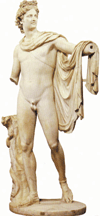
Apollo
Belvedere
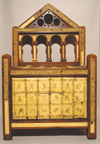
Reproduction of the Bishop's Throne of St.
Peter.
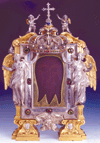
Mandylion of Edessa, 3rd-5th Century, tempura on
linen attached to wood, silver, gold and precious stones. Considered
the oldest image
of Christ, faint image of
face in
center.
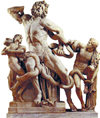
Sculpture of Laocoon's
death from snakes sent by
goddess Athena.
(Courtesy http://www.christusrex.org/)
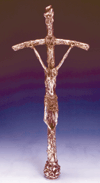
Crosier of Pope Paul VI
& Pope John Paul
II

Mosaic
fragment of
St. Peter, 5th c.
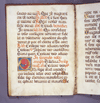
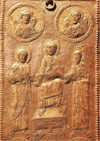
9th c.
silver gilt casket or box for holding a cross; image depicts Christ
enthroned between Peter and Paul.
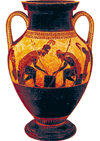
Ca.
530 B.C. Greek amphora showing Achilles and Ajax playing a board
game;
imported and used by Etruscans.
|